|
|
|
| Selected
Article |
An
Introduction To Schutzhund Dog Training

“The shepherd dog is
a service dog and must be bred as a service dog and must be judged
as a service dog. With service dogs, suitability ranks higher
than beauty and their only nobility consist in their complete
adaptability in the arrangement, balancing and coalescence of
each and every part."
–Max
von Stephanitz
The History of Schutzhund
In the late 1800’s the herding
dogs of Germany were unkempt semi-wild creatures that spent most
of their lives on the rugged hills herding and guarding flocks.
Good herding dogs were in great demand so farmers and breeders
got together with an aim to produce a national shepherd dog.
Things progressed slowly until in 1889 a certain Captain Max
von Stephanitz attended a dog show in Karlruhe and saw a dog
that impressed him so much he bought it to begin breeding the
perfect herding dog. This dog was Hector Linksrein (later changed
to Horand von Grafrath) a working, wolf like dog with strong
herding instincts and a fearless nature. Horand von Grafrath
was the first registered German
Shepherd Dog and was to join Max von Stephanitz on a lifelong
journey to breed a dog with strong working abilities, intelligence
and endurance and to lead to the beginnings of Schutzhund Trials.
Schutzhund began in the early 1900’s as a working test
for German Shepherd dogs. The creator and “father” of
the breed, Max von Stephanitz had founded the “Verein fur
Deutsche Schaferhunde” (the German Shepherd Club or the
S.V.) Through the club Max wrote the breed standard with emphasis
placed not on appearance but on the dogs working ability, utility
and intelligence. Popularity for this dog grew and so did Max’s
battle to keep the breed true to type. By 1901, disappointed
at the rise of GSD’s as show dogs and the decline in sheep
farming, Max von Stephanitz introduced herding trials to reinstate
the GSD as a working dog. The trials were a huge success and
led to the “manwork” or “Schutzhund” competitions
of today.

Schutzhund - The Sport
| “The success for all
employment as an assistant of man depends in the first
place on expert leadership, whereby the dog is always put
in just the right place, and where the man is so well acquainted
with the peculiarities of the dog that he always knows
how to interpret correctly the meaning of the dog’s
signs.” |
–Max
von Stephanitz |
The translation of the word “Schutzhund” is “protection
dog”. The Verein fur Deutsche Shaferhunde (SV) club further
developed Schutzhund to test the mental and physical capabilities
of the German Shepherd Dog. The overall aim of Schutzhund is
to develop and evaluate the working ability of the dog as a means
of improving and maintaining a reliable breeding stock. Schutzhund
dogs are screened for hip and elbow dysplasia and other deformities.
Puppies born to Schutzhund dogs are more likely to be of a reliable
temperament, intelligent and have great strength and endurance.
Stage One - Begleithund (Companion
dog Test) (BH)
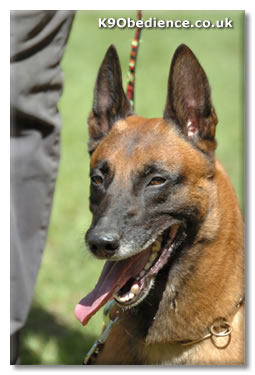
Before any dog can enter Schutzhund
trials it must have passed a BH test. For this test the dog is
kept on lead. The BH test is in two parts, A & B.
When on lead, the dog must wear a chain type collar and is awarded
points for each part completed. All size or breeds are eligible.
The dog must be a minimum of 13 months old.
Part A - Companion Dog Test:
Heeling on lead, 15 points -
Singly and amongst a group, the dog performs heelwork. The dog’s
shoulder blades must be level with the handler’s knees.
Heeling off lead. 15 points -
Singly and amongst a group, the dog performs heelwork. At some
point a gun is fired and the dog must remain completely indifferent
to the noise.
Sit, 10 points -
When heeling the handler must command the dog to sit. Without
pausing the handler continues walking for several paces then
turns and faces the dog. On the judges word the handler returns
to the dog who assumes the heel position.
Down with Recall, 10 points -
With the dog heeling, the handler commands the dog to “down”.
The dog must lie down promptly. The handler continues without
pausing for 30 paces and turns to face the dog. On the judge's
signal the handler recalls the dog. The dog must recall quickly
and sit close in front of the handler. The dog is commanded to
heel and returns to the handler's left side.
Long Down, 10 points -
Handler commands dog to lay down at a spot chosen by the judge.
Handler moves 40 paces away within sight of but not facing the
dog. The dog must stay in the down position while another dog
works around it.
Part B - Companion Dog Test:
This part consists of tests designed
to evaluate the dog’s ability to work in or near heavy
traffic.
Ability to perform in traffic -
The handler and the judge walk near a designated road. The dog
must heel calmly on a loose lead. The dog must remain indifferent
towards pedestrians, joggers and all traffic. The handler and
dog return to the judge. The handler and the judge shake hands
and converse. The dog should ignore the judge and is allowed
to sit, stand or lie down but must remain calm and indifferent.
Behaviour of dog under extreme traffic conditions -
The dog and handler move through heavy traffic and noisy pedestrians.
The handler must stop and command the dog to sit then both move
on. The handler must then command the dog to lie down then both
move on. The dog must be calm throughout.
Behaviour of dog alone during traffic conditions -
Handler and dog go to a quiet road. The handler secures the dog
to a suitable post and goes out of sight for two minutes. In
this time another handler and dog will pass within 5 paces of
the dog that must remain calm and indifferent. Handler returns
to dog. The dog is disqualified if it shows signs of insecurity.
The judge is evaluating the dog as to its approachability and
its steadiness near traffic.
At no point should the dog show nervousness, aggression, shyness
or fear in the company of strangers, cyclists or joggers or other
dogs. The BH is either a pass or a fail. If a dog passes the
test it is deemed to have the right temperament to enter the
Schutzhund phase.
Schutzhund Titles
| “In a real struggle
with a man, the chief consideration is that the dog help
his master quickly and efficiently, and not bother his
head too much about overpowering his adversary according
to the Queensbury Rules” |
|
The dog must be a minimum of 18 months
old and possess a BH (companion dog) title.
Schutzhund consists of three parts, tracking, obedience and
protection work. To obtain a Schutzhund title the dog must pass
all three phases. Each phase has a point system with the maximum
being 100 points. Each dog and its handler must score a minimum
number of points, 70 in the Obedience and Tracking phase and
80 in the Protection phase before gaining a degree.
There are three major Schutzhund degrees, SchH I, SchH II and
SchH III. Each degree is increasingly more difficult, demanding
more accuracy and performance from both handler and dog.
SchH I - Phase A Tracking:
The dog must be a minimum of 18 months
old and possess a BH (Companion Dog) title.
The tracking phase is also a test of the dog’s mental soundness
as well as its tracking abilities. The length and the difficulty
of the track depend on which Schutzhund level is being competed
for. A track is laid down by the handler of 350-400 paces by
walking over a surface such as dirt or grass. The track includes
two 90 degree turns and objects are left at the middle and end
of the track. The track is laid 20 minutes beforehand. The handler
attaches his dog to a long tracking lead and follows behind as
the dog scents out the trail.
The handler may not apply pressure or force to the dog. The handler
lets out 10 meters of lead as the dog finds the scent and tracks.
When the dog finds an object on the track it indicates the find
by lying down with the object between its front paws. This is
a great test of the dog's scenting ability and a useful indicator
as to its trainability.
SchH I - Phase B Obedience
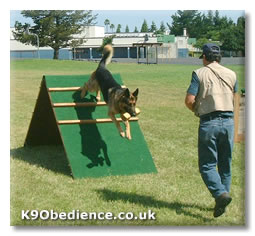 This
phase is made up of a series of heeling exercise. On lead, the
dog has to adopt a perfect heeling position as its handler weaves
amongst groups of people. As the dog performs there is a gun
shot test to ensure that the dog will not react to loud noises.
There is also a series of field exercises with the dog being
asked to sit, lie down and stand as the handler walks on. The
handler must recall the dog from these positions. The dog is
required to retrieve dumb bells of various weights on a flat
surface, over a one meter hurdle and over a six foot slanted
wall. The dog must also perform a send away then lie down and
stay in the down position despite distractions around it. The
obedience exercises test the dog’s temperament, structural
efficiencies and its willingness to obey its handler. There is
a maximum of 100 points awarded of which 70 points are required
to pass. This
phase is made up of a series of heeling exercise. On lead, the
dog has to adopt a perfect heeling position as its handler weaves
amongst groups of people. As the dog performs there is a gun
shot test to ensure that the dog will not react to loud noises.
There is also a series of field exercises with the dog being
asked to sit, lie down and stand as the handler walks on. The
handler must recall the dog from these positions. The dog is
required to retrieve dumb bells of various weights on a flat
surface, over a one meter hurdle and over a six foot slanted
wall. The dog must also perform a send away then lie down and
stay in the down position despite distractions around it. The
obedience exercises test the dog’s temperament, structural
efficiencies and its willingness to obey its handler. There is
a maximum of 100 points awarded of which 70 points are required
to pass.
SchH I - Protection
This is a test of the dog’s
courage, physical strength and agility. It also tests the handler’s
absolute control of the dog. The dog must search hiding places
to find a human decoy and should then immediately and continuously
bark but not grip the decoy. At the judge's call, the handler
recalls the dog and holds it to allow the decoy to move from
hiding. The decoy hides again at least 50 paces away. Upon the
judge's signal the handler goes with the dog towards the hiding
place. The decoy moves to attack the handler. The dog must instantly
attack and grip firmly on the padded sleeve. The decoy strikes
the dog twice with a padded stick.
At the judge's call the decoy stops fighting and immediately
the dog must release its grip. The human decoy then attempts
to escape. The handler remains still and sends the dog after
the decoy. The decoy turns and using threats and aggression attacks
the dog. The dog must grip the decoy firmly. The decoy ceases
resistance and instantly the dog must release its grip. The handler
must remain still and not influence the dog during this attack.
Upon the judge's call the handler approaches and searches the
decoy. The decoy is then marched to the judge with the dog and
handler following behind. On the way the decoy will attempt to
attack the handler. The dog must without hesitation protect the
handler by again gripping the decoy on the padded sleeve.
The decoy is always suitably padded and all bites from the dog
must be on the padded sleeve and the dog must instantly release
its grip as soon as the decoy discontinues the fight or upon
command from its handler. There must be no hesitation.
The judge will be awarding points based on the dog’s fighting
drive, courage and strength. Only enthusiastic fighting and a
firm grip merit full points. Any dog that does not release its
grip when the decoy ceases fighting or upon command from the
handler, fails instantly.
Schutzhund II
The dog must be a minimum of 19 months
old and hold a SchH I degree.
SchH II repeats the test as in SchH I but the tests are more
difficult and more is expected of the dog. This shows a greater
endurance level and control. There are two turns in the track
with two objects to find. The dog must retrieve over a five foot
wall. The track will have been laid 30 minutes earlier by a stranger.
Schutzhund III
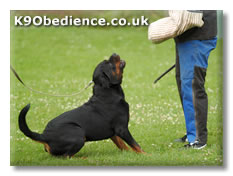
This is the master’s degree.
The dog must be a minimum of 20 months old and be in possession
of a SchH I and a SchH II degree.
The tests are far more difficult and all exercises are performed
off lead. The stand must be executed from a running and walking
position. The dog must follow a track laid by a stranger 60 minutes
earlier. There are four turns in the track and three objects
to find. The dog must retrieve various weights of dumb bells
from a flat surface, over a one metre hurdle and a six foot slanted
wall.
The dog’s fighting instinct is evaluated during the protection
phase. If the dog has a firm grip on the decoy’s padded
sleeve and releases grip instantly on command but continues to
bark and if the dog avoids the stick but still comes back at
the aggressor, this shows a dog with pronounced fighting instincts.
Throughout the protection phase the judge will be evaluating
the “natural tendencies shown by dog”. This includes
drive structure, self assuredness and the ability to handle stress.
Schutzhund III shows the highest level of the dog’s strength,
obedience, agility, eagerness and confidence. Only a small percentage
of dogs have the necessary drive, intelligence and stamina to
achieve a Schutzhund III title.
Points system explained
| “The Motto for work
on Man, of any and every description is firstly, Obedience,
secondly Obedience and thirdly, lastly, and always Obedience” |
–Max
von Stephanitz |
Points are awarded for every exercise
the dog performs within each phase. Each of the three phases,
Obedience, Tracking and Protection have a total maximum of 300
points. The dog has to receive a minimum of 70 points in obedience
and tracking and 80 points in protection. The points are as follows:
Unsatisfactory 0 – 109 points
Insufficient 110 – 219 points
Satisfactory 220 – 239 points
Good 240 – 269 points
Very Good 270 – 285 points
Excellent 286 – 300 points
The Schutzhund judge also looks at the overall performance of
the dog and based on these awards each exercise a grading. There
are five gradings and in each grade is a band of points. For
example:
Excellent (V) 10 points
Very Good (SG) 9-9.5 points
Good (G) 8-8.5 points
Satisfactory (B) 7-7.5 points
Insufficient (M) 0-6.5 points
The judge assesses whether the handler has a good working relationship
with his dog and whether the dog performs eagerly and with enthusiasm.
Also taken into consideration is whether the Schutzhund Trial
is at club, national or international level. Anyone competing
at international level is under the strictest scrutiny and observant
eyes of the judge who will be expecting a high level of performance.
Awards are also given for courage, hardness and combativeness
as follows:
Pronounced (P) Ausgepraegt
Satisfactory (S) Vorhanden
Insufficient (I) Nicht Genugend
If the dog breaks a long down or moves more than three metres
away in the obedience phase, all points are lost. A minimum of
42 points must be gained before passing on to the tracking phase.

Other Schutzhund Titles
| “Know what your work
is and do it” |
–Max
von Stephanitz |
Faehrtenhund Pruefung (Advanced
Tracking)
This is an advanced tracking exam
in which the dog has to scent the track and not the body scent
of the track layer. The track layer is not allowed to live in
the same house as the handler and dog.
There are three levels: Fh I, Fh II and Fh III becoming progressively
more difficult. The track has several turns over which the dog
must remain “track sure” and not deviate from the
scent even when rounding corners. The track can be laid through
forests, ploughed fields or meadows. The track must change cover
so some of it lies across a street or footpath. The track must
have at least one cross track and have at least one 90 degree
turn. Four objects that are strips of wood, leather or carpet
are laid at intervals on the track. The dog must indicate the
objects by lying down with the object between its front paws.
Only a small portion of the track is allowed to be across snow.
The age of the track depends on the level the dog is competing
for. This ranges from 1.5 hours old to 4 hours old.
The dog can be worked on a slip collar, in a tracking harness
or off lead. The dog is disqualified if it air scents. The dog
is disqualified if it swings wide from the track. The dog is
disqualified if it chases wildlife or if it does not indicate
the objects.
Scoring is done based on the dog’s performance, how it
indicates the objects, its responsiveness to its handler and
on its general working abilities. German Shepherd Dogs are exceptional
advanced tracking dogs. The GSD has three nasal passages of different
size, shape and length. A GSD following
a ground scent track can detect even the slightest change in
scent.
Wachthunde (WH) Watchdog Certificate
This test repeats the requirements
of the Begleithunde (Companion Dog) exercises but includes guarding
and watchdog tests.
Ausdauerprufung (AD) Endurance
Test
The dog must be a minimum of 16 months
old or a maximum of 7 years and must possess a SchH I degree.
The AD is usually held at club level and may not be carried out
between the hours of 11 a.m. to 2 p.m. when the outdoor temperature
is at its highest.
Dogs must be in excellent health.
Bitches that are on heat, pregnant or nursing may not enter.
The judge marks the points in a score book. The dog is tested
running alongside its handler on a bicycle (mountain and racing
bikes are not allowed) at a steady trot over a total of 12 miles.
The lead must be long enough to allow the dog to adjust its pace.
If the dog lags behind it will be immediately disqualified.
Large dogs run for 5 miles (8km) then rest while the judge examines
them for signs of fatigue for which it will be disqualified.
Large dogs then run on for a further 4.3 miles (7kg) after which
they have a 20 minute rest. In this time the judge again examines
the dog for signs of fatigue and also checks the dogs paws for
cracks or sores for which the dog will be disqualified. The endurance
exercise continues until the dog has covered a total of 12 miles,
(19.32km) After a short rest the dog performs some obedience
exercises to prove that it can work when fatigued. There is no
gunshot test.
Medium sized dogs trot over a slightly shorter distance.

Schutzhund Today
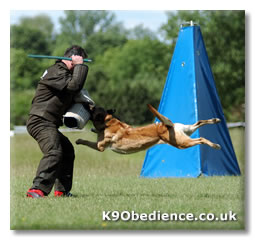
“The dog can tell from
the glance of the trainer the state of the trainer’s soul”
–Max
von Stephanitz
Started by the “Verein fur Deutsche
Shaferhunde, (SV) club, Schutzhund is now a recognised canine
sport worldwide. The SV club is the largest single breed club
in the world.
Today’s Schutzhund is governed by a number of different
organisations. The Federation Cynologique Internationale (FCI)
is an international kennel club based in Thuin, Belgium. The
club was founded in1911 by Germany, Austria, Belgium, France
and the Netherlands and today is an international umbrella organisation
for everything associated with dogs.
The club promotes and protects cynology and purebred dogs and
recognises 335 breeds which are divided into ten groups. The
FCI sanctions international Schutzhund trials with their “Internationale
Pruefungsordnung” or IPO titles. However the “Verein
fur Deutsche Shaferhunde” (SV club) still have arguably
the most powerful influence on the sport.
Schutzhund is enjoyed by millions of people from all walks of
life and from countries across the world. Many people enter the
sport to experience the opportunity to train their dogs to a
high standard and to gain recognition for their abilities as
a handler and their dog’s ability to perform. It is no
longer only a sport for German Shepherd Dogs. Other breeds such
as Rottweilers, Dobermans, Giant
Schnauzers, Boxers, Malinois
Belgian Shepherds and American
Staffordshire Terriers are now active members in many Schutzhund
clubs worldwide. However, the German Shepherd Dog still remains
a close favourite for the Schutzhund titles, because the sport
is and always will be a great part of the breed’s heritage.
The working relationship between a Schutzhund dog and its handler
is a beautiful picture of the human-canine relationship. Far
from being a 'killer' or 'attack' dog (as so many people seem
to wrongly believe), the Schutzhund dog has total mental stability,
confidence and is steady and reliable both in the field and in
the family home. In fact, dogs that are dangerous are usually
so through their fears or timid mindsets. Such a dog may be unpredictable
and unsafe around children and members of the public, and such
an unstable nervous dog could never pass even the most basic
of Schutzhund titles. On the other end of the scale, perhaps
more importantly too, a dog which is over confident or aggressive
is equally unsuitable for Schutzhund trials, and as such would
not survive the tests.
The founding fathers of Schutzhund and protection dog sports
were not aggressive or tyrannical men, lustful of seeing a dangerous
dog which they could threaten poeple with on the end of a lead.
The exact opposite is the case, they wanted to secure the stability
of their breed's mentalities, and in doing so, to secure the
future success of their beloved breed, with emhphasis on sociability,
calmness and reliability, as well as obedience and steadfastness
of course.
If you are interested in Schutzhund there is probably a club
reasonably near to where you live but be warned, the sport is
highly addictive and requires a tremendous amount of time and
energy. All Schutzhund members would agree that to develop such
a wonderful working relationship with your dog is a lifetime
of hard work and pleasure. How we feel about our dogs is summed
up in the words of the “father” of the German Shepherd
breed:
| “All the wonderful
qualities of character possessed by a good shepherd dog
will therefore only be brought to light when he remains
in the same hands for a very long time from puppy hood,
where having obtained a footing in house, he shares the
joys and sorrows of the family, their work and their duties.“ |
–Max
von Stephanitz |
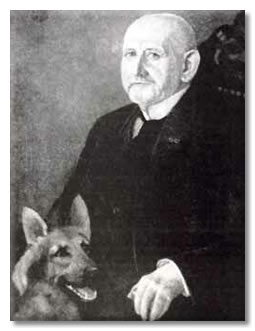 Max von Stephanitz
Max von Stephanitz
|
|
|
|
|
|





